| C H A P T E R 1 |
|
Introduction |
This chapter provides an overview of the features, configurations, and system requirements of the Sun Netra CP3220 blade server.
This chapter contains the following topics:
The Sun Netra CP3220 blade server is a high-performance, single-board computer based on an AMD Opteron X64 processor. The blade server is designed for high availability in a switched network computing environment. This blade server is compliant with Advanced Telecommunications Computing Architecture (ATCA) specifications (PICMG 3.0 and PICMG 3.1). It can achieve greater performance levels than previously supported CompactPCI® (cPCI) standards-based products targeted for Telco markets.
The ATCA standard comprises the PICMG 3.0, 3.1, 3.2, and 3.3 versions of the standard. The Sun Netra CP3220 blade server complies with the following specifications:
The Sun Netra CP3220 blade server features include:
The following figures show the front panels of the Dual-Core and Quad-Core Sun Netra CP3220 blade server.
FIGURE 1-1 Sun Netra CP3220 Dual-Core Blade Server (Front View)
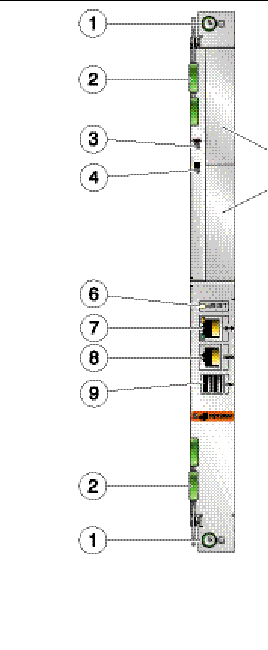
FIGURE 1-2 Sun Netra CP3220 Quad-Core Blade Server (Front View)

FIGURE 1-3 Sun Netra CP3220 Blade Server (Component Side View)
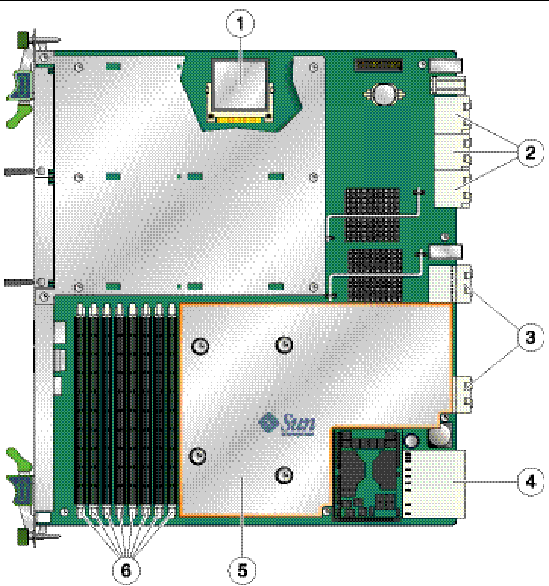
Sun Netra CP3220 blade servers can be installed into an ATCA shelf (chassis), as shown in FIGURE 1-4. The blade servers can be deployed in various electrical configurations to suit user requirements. For example, the blade server can be configured to boot from a network as a diskless client with either a front panel or advanced rear transition module (ARTM) network connection. The Sun Netra CP3220 blade server has a slot for a Compact Flash card (optional) and 8 DIMM sockets for memory.
FIGURE 1-4 Sun Netra CP3220 Blade Server in Shelf Enclosure

The Sun Netra CP3220 blade server has two AMC slots, with four lanes each of PCIe, to provide additional I/O to the front panels or to the rear of the enclosure when used with an advanced rear transition module.
The Sun Netra CP3220 blade server supports AMC.1 Type 4E2 cards, as defined by the AMC specification.
You can install an optional Sun Netra CP32x0 Advanced Rear Transition Module (ARTM) (FIGURE 1-5) into the rear of the ATCA shelf, opposite the Sun Netra CP3220 blade server (FIGURE 1-6).
The Sun Netra CP32x0 SAS Storage Advanced Rear Transition Module, Dual HD provides the following components:
FIGURE 1-5 Sun Netra CP32x0 SAS Storage Advanced Rear Transition Module, Dual HD
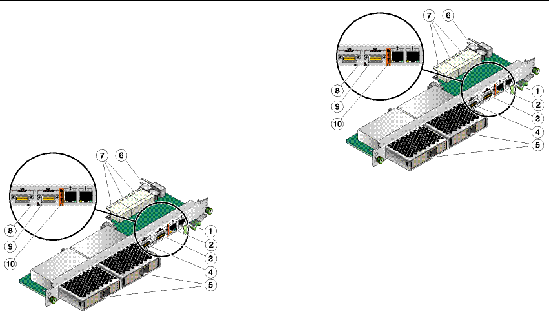
| Note - Use only serial cables that are less than 10 meters in length. |
FIGURE 1-6 shows the physical relationship between the Sun Netra CP3220 blade server, the ARTM, and the backplane in a typical ATCA system.
FIGURE 1-6 Sun Netra CP3220 Blade Server, Backplane, and Relationship to ARTM
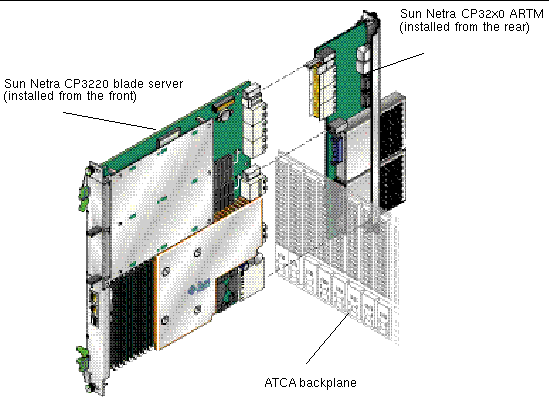
| Note - When using the Sun Netra CP32x0 ARTM with the Sun Netra CP3220 blade server, use shielded cables of less than 10 meters in length for serial I/O ports. |

|
Caution - You must use shielded cables for all ports to satisfy EMI compliance standards. |
You can order the CP32x0 ARTM, build a custom module, or buy one from an IHV. You must set up a minimal set of I/O for a boot path for the host board and for a path for console I/O to deliver commands and read board and system status.
Possible boot and console configurations are described in TABLE 1-1. Sun Microsystems provides the Sun Netra CP3220 blade server and optionally, a compatible Sun Netra CP32x0 ARTM. This module provides one 10/100/1000BASE-T per second Ethernet RJ-45 port from the host to the rear of the system. This port can be used to accomplish, optionally, a network boot as a diskless client. The other configurations require IHV hardware.
|
Sun Netra CP32x0 ARTM, supplied as an option for rear access |
The default boot path uses an Ethernet port; the blade server runs in a diskless client configuration |
|
|
Available only with the optional Sun Netra CP32x0 SAS Storage Advanced Rear Transition Module, Dual HD or through an AMC card with SAS capabilities. When the optional rear transition module is installed, connect to the drive(s) via SAS ports on the rear transition module. |
||
|
Serial port A on the front panel provides the path of the default console I/O. When the optional transition module is installed, the module’s
|
||
|
Sun Netra CP3220 blade server supports one, optional IDE Compact Flash drive, either 8-Gbyte (Type I) or 16-Gbyte (Type II), installed in a Type II CF socket on the blade. |
In general, the hot-swap process includes the orderly connection of the hardware and software. The process uses hardware connection control to connect the hardware in an orderly sequence. The process includes the use of pins of different lengths to accomplish signal sequencing to protect the hardware and avoid corrupting the system interface. For further details on hot-swap standards, see the ATCA hot-swap specification.
The ATCA specification describes three hot-swap models: basic hot-swap, full hot-swap, and HA hot-swap. When a Sun Netra CP3220 blade server functions as a node board it supports all three hot-swap models.
This section contains the system-level hardware and software components, required and optional, for the Sun Netra CP3220 blade server.
The Sun Netra CP3220 blade server cannot be used as a stand-alone system. It is designed to be used in an ATCA chassis for 8U boards. The minimum hardware requirements needed to use the Sun Netra CP3220 blade server are as follows:

|
Caution - You can damage the Sun Netra CP3220 blade server components if you install the blade server in a chassis that does not provide sufficient cooling. For more information, see Section 2.2.1.1, Check Power, Thermal, Environmental, and Space Requirements. |
| Note - Use only shielded serial cables that are less than 10 meters in length. |
You can order the following optional items:
The Sun Netra CP32x0 ARTM enables rear system I/O access to the following:
The Sun Netra CP3240 switch is capable of operating at 10 GB, but is set by default to operate at 1GB. To use the switch at 10 GB, perform a one-time configuration procedure, available in the CP3x40 Switch Product Notes (820-3260).
The Sun Netra CP3220 blade server has been tested for compatibility with the Solaris 10 Operating System (Solaris OS) and WindRiver Linux.
10 Operating System (Solaris OS) and WindRiver Linux.
Refer to the Sun Netra CP3220 Blade Server Product Notes (820-1980) for more Solaris OS information, including a list of any required Sun Netra software patches and support for subsequent versions of Solaris. You can view and download the latest version of the product notes at the following web site:
http://docs.sun.com/app/docs/prod/cp3220.brd#hic
Refer to the appropriate vendor documentation for more information on your operating system.
Should you have any technical questions or support issues that are not addressed in the Sun Netra CP3220 blade server documentation set or on the technical support web site, contact your local Sun Services representative. This hardware carries a one-year return-to-depot warranty.
For customers in the U.S. or Canada, please call 1-800-USA-4SUN (1-800-872-4786).
For customers in the rest of the world, you can find the World Wide Solution Center nearest you at the following web site:
http://www.sun.com/contact/services_solutions.jsp
When you call Sun Services, be sure to indicate if the Sun Netra CP3220 blade server was purchased separately and is not associated with a system. Please have the blade server identification information ready. For proper identification of the blade server, be prepared to give the representative the blade server part number, serial number, and date code (FIGURE 1-7).
The Sun Netra CP3220 blade server part number, serial number, revision number, and media access control (MAC) address are printed on stickers located on the Sun Netra CP3220 blade server (FIGURE 1-7).
The Sun barcode label provides the following information:
The part number/dash/revision/date code label provides the following information:
The MAC address label contains the base MAC address for the blade server in printed and barcode form. Is it an orange label located below the AMC slots.
FIGURE 1-7 Sun Netra CP3220 Blade Server Barcode Labeling
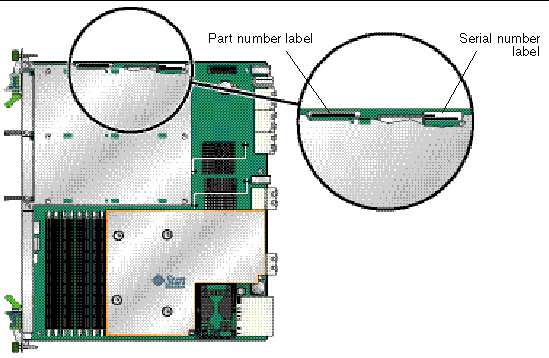
Copyright © 2009 Sun Microsystems, Inc. All rights reserved.